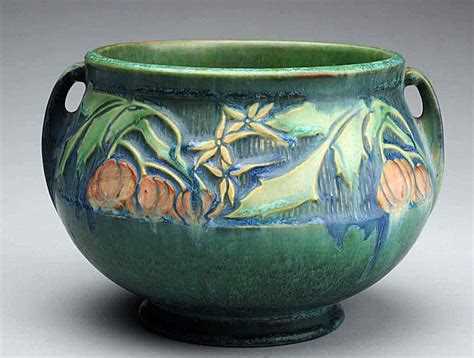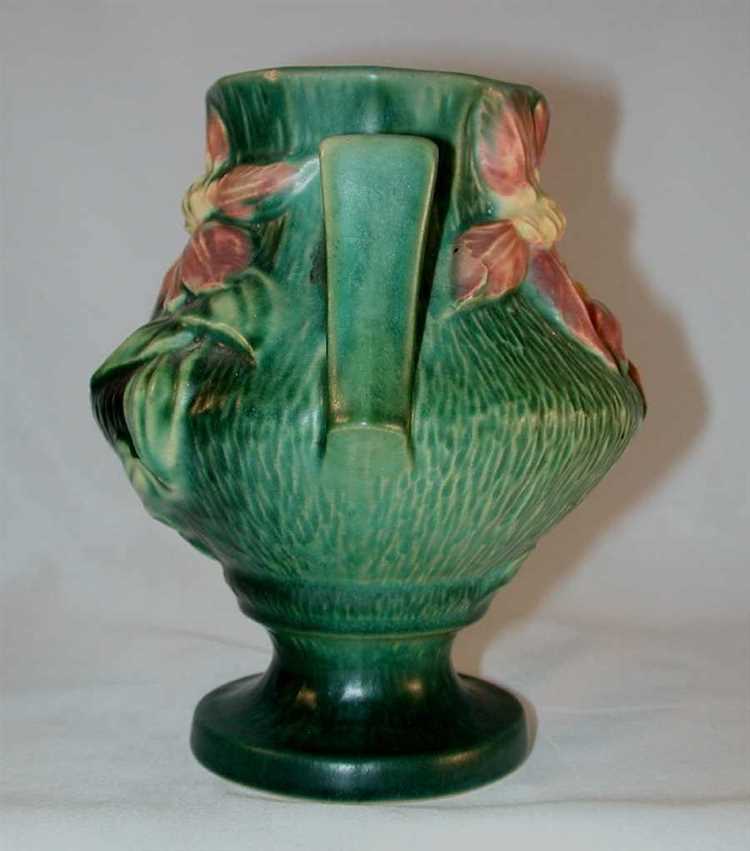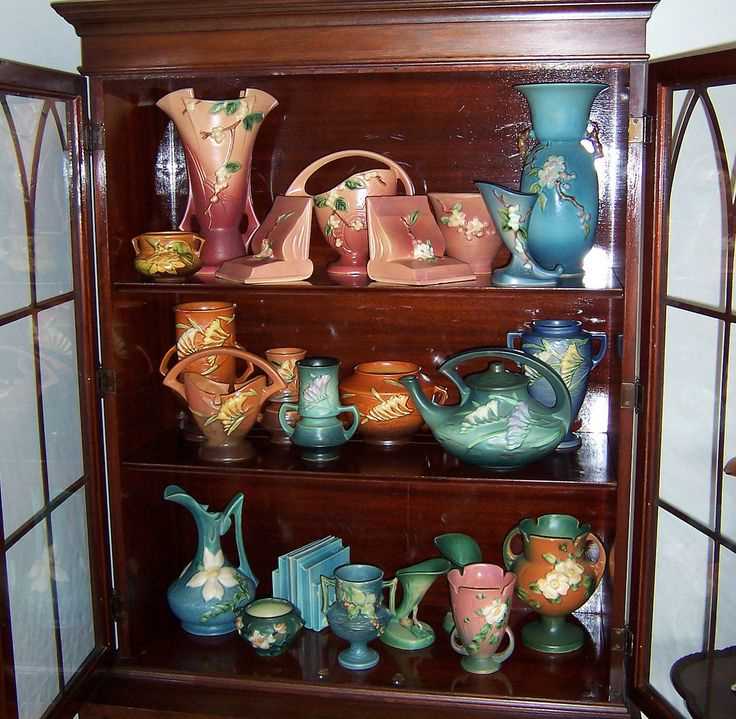Roseville Pottery has long been regarded as one of the finest examples of American art pottery. With its intricate designs and high-quality craftsmanship, it’s no wonder that collectors and enthusiasts still value Roseville Pottery today. But is it still as valuable as it once was?
Despite a decline in overall value over the years, Roseville Pottery is still highly sought after and considered valuable by collectors. While some pieces may not command the same prices they did in the past, others have actually increased in value.
One of the factors that determine the value of Roseville Pottery is its rarity. Certain lines or patterns were produced in limited quantities, making them more valuable to collectors. Additionally, the condition of the piece plays a significant role in its value. Mint condition pieces with no chips, cracks, or repairs tend to be more valuable than those with flaws.
Another significant factor is the popularity of the specific line or pattern. Some Roseville Pottery lines have maintained a strong following and continue to be highly sought after, increasing their value. Collectors often have particular preferences and will pay a premium for specific designs or styles.
Overall, while the market for Roseville Pottery may have changed over time, the value of certain pieces remains strong. Collectors and enthusiasts can still find valuable and sought-after pieces, making Roseville Pottery a worthwhile addition to any collection.
The History of Roseville Pottery
Roseville Pottery was a highly renowned American pottery company that operated from 1892 until 1954. Founded in Roseville, Ohio by George F. Young and his partner George Young Jr., the company initially produced functional stoneware and utilitarian items.
However, Roseville Pottery gained popularity for its art pottery designs, which featured intricate patterns and vibrant colors. The company took advantage of the growing Arts and Crafts movement in the early 20th century and produced a wide range of decorative pieces, including vases, planters, jardinières, and wall pockets.
One of the defining characteristics of Roseville Pottery was its use of innovative and complex glazes. The company experimented with various glaze techniques, including drip glazes, matte glazes, and blended glazes. These glazes not only added depth and dimension to the pottery but also made each piece unique.
Roseville Pottery’s popularity peaked in the 1920s and 1930s when its art pottery designs became highly sought after. The economic depression in the 1930s, however, negatively impacted the demand for luxury items like art pottery. Despite this setback, Roseville Pottery continued to produce utilitarian pottery to sustain its business.
During World War II, Roseville Pottery shifted its production to more practical items like cookie jars and flowerpots due to limited resources and a change in consumer preferences. The war marked a significant decline in the company’s art pottery production.
After the war, Roseville Pottery struggled to regain its pre-war success. The company faced fierce competition from mass-produced ceramics and changing consumer tastes. In 1954, Roseville Pottery ceased operation, marking the end of an era.
Today, Roseville Pottery is highly collectible and treasured by collectors around the world. Its unique designs, quality craftsmanship, and artistic value have contributed to its enduring popularity. Collectors avidly seek out Roseville Pottery pieces at auctions, antique stores, and online platforms, making it a valuable and sought-after investment.
Collecting Roseville Pottery Today
Collecting Roseville Pottery has become increasingly popular over the years, with many enthusiasts adding these beautiful pieces to their collections. Here are some things to consider if you’re interested in collecting Roseville Pottery.
- Research: Before starting your collection, it’s important to research Roseville Pottery to familiarize yourself with different patterns, shapes, and marks. This will help you make informed decisions and identify valuable pieces.
- Condition: One of the most important factors in determining the value of Roseville Pottery is its condition. Look for pieces that are free from cracks, chips, and repairs. Minor flaws may be acceptable, but major damage can significantly reduce value.
- Authenticity: Due to the popularity of Roseville Pottery, there are often replicas and fakes in the market. It’s crucial to learn how to distinguish authentic pieces from reproductions. Look for proper markings, glaze consistency, and overall craftsmanship.
- Collecting by pattern or theme: Roseville Pottery offers a wide range of patterns and themes, including floral, landscape, and abstract designs. Some collectors choose to focus on specific patterns or themes to create a cohesive collection.
- Price guide: Utilize price guides and online resources to get an idea of the current market value for Roseville Pottery. Keep in mind that prices can vary based on rarity, condition, and demand.
- Displaying and caring for your collection: Once you’ve started collecting Roseville Pottery, it’s important to display and care for your pieces properly. Consider using glass cabinets or shelves to protect them from dust and sunlight. Avoid exposing them to extreme temperatures or humidity.
In conclusion, collecting Roseville Pottery can be a rewarding hobby for those who appreciate its artistic value and historical significance. By researching, understanding authenticity, and considering condition, collectors can build valuable and beautiful collections of Roseville Pottery.
Factors that Determine the Value of Roseville Pottery
When it comes to determining the value of Roseville Pottery, there are several factors that collectors and enthusiasts take into consideration. These factors can greatly influence the price of a piece, and understanding them can help you assess the worth of your own Roseville Pottery collection.
- Rarity: One of the most significant factors in determining the value of Roseville Pottery is its rarity. Pieces that were produced in limited quantities or those that are hard to find are generally more valuable than more common pieces.
- Condition: The condition of the piece also plays a crucial role in determining its value. Pottery that is in excellent condition, with no cracks, chips, or repairs, will typically be worth more than pieces that show signs of damage or wear.
- Age: The age of a piece can also influence its value. Generally, older pieces are considered more valuable, especially if they belong to a specific period or style that is highly sought after by collectors.
- Design and Pattern: The design and pattern of a Roseville Pottery piece can greatly affect its value. Some designs or patterns may be more popular and desirable among collectors, leading to higher prices.
- Artist: Roseville Pottery was produced by various artists, and pieces created by well-known or highly skilled artists tend to be more valuable. The reputation and skill level of the artist can significantly impact the price.
- Collectibility: The overall collectibility of Roseville Pottery as a brand can also impact the value of individual pieces. If the demand for Roseville Pottery is high among collectors, it can drive up the prices of all pieces, regardless of their specific characteristics.
It’s important to keep in mind that the value of Roseville Pottery can fluctuate over time as trends and collector preferences change. Additionally, factors such as the presence of original packaging or documentation, specific markings or signatures, and historical significance can also influence the value of a piece.
If you’re interested in selling or buying Roseville Pottery, it’s recommended to consult with experts or specialized dealers who can provide insights and accurate assessments based on these factors.
Identifying Authentic Roseville Pottery
Roseville Pottery is a popular collectible for many antique enthusiasts. However, due to its popularity, there are also many replicas and fakes in circulation. Here are some tips to help you identify authentic Roseville Pottery:
- Research and Familiarize Yourself: Before purchasing Roseville Pottery, it’s essential to research and familiarize yourself with the different patterns and designs produced by the Roseville Pottery Company. Look for reference books, online resources, and reputable dealers who can provide accurate information.
- Inspect the Markings: Authentic Roseville Pottery pieces are typically marked with the Roseville logo or a signature. The markings should be clearly stamped and legible. Take time to study these markings and compare them to known authentic examples.
- Examine the Quality of Craftsmanship: Roseville Pottery is known for its high-quality craftsmanship. Look for clean lines, intricate details, and smooth finishes. Pay attention to any imperfections or inconsistencies that may indicate a fake or lower-quality piece.
- Consider the Glaze: Roseville Pottery is known for its beautiful and distinctive glazes. Each pattern has unique glaze characteristics that can help verify authenticity. Study the colors, textures, and variations in the glaze to ensure they match known authentic examples.
- Check for Repairs or Restorations: Inspect the piece for any signs of repairs or restorations. Scratches, chips, and cracks can diminish the value of Roseville Pottery, so it’s essential to carefully examine the piece for any damages that may have been repaired.
- Consult Experts or Reputable Dealers: If you’re unsure about the authenticity of a particular piece, it’s always a good idea to consult experts or reputable dealers who specialize in Roseville Pottery. They can provide valuable insights and help authenticate the piece.
- Beware of Red Flags: Be cautious of extremely low prices, vague descriptions, and suspicious sellers. If something seems too good to be true, it probably is. Trust your instincts and only purchase from reliable sources.
By following these tips and taking the time to educate yourself, you can increase your chances of identifying authentic Roseville Pottery pieces and avoid purchasing replicas or fakes.
Tips for Buying Roseville Pottery
If you are interested in collecting Roseville Pottery, here are some tips that can help you make informed buying decisions:
- Do your research: Before purchasing any Roseville Pottery, it is important to educate yourself about the different patterns, styles, and values associated with it. Familiarize yourself with the various marks and signatures used by Roseville Pottery to identify authentic pieces.
- Inspect the condition: When buying Roseville Pottery, carefully examine the piece for any damage, such as chips, cracks, or repairs. Minor imperfections can lower the value of the pottery, so it’s important to know the condition before making a purchase.
- Buy from reputable sellers: To ensure you are purchasing authentic Roseville Pottery, it is advisable to buy from reputable sellers, such as antique dealers, auction houses, or reputable online platforms. Research the seller’s reputation and read customer reviews before making a purchase.
- Consider the rarity: Certain patterns or designs of Roseville Pottery are more rare and valuable than others. Research the rarity of the piece you are interested in to determine its potential value.
- Attend pottery shows and auctions: Pottery shows and auctions are great places to find a wide selection of Roseville Pottery. Attend these events to get a better understanding of the current market value and to find unique pieces.
- Ask for certificates of authenticity: If you are purchasing a high-value piece of Roseville Pottery, it is a good idea to ask for a certificate of authenticity from the seller. This document provides proof that the piece is genuine and can increase its value.
- Take your time: Buying Roseville Pottery is an investment, so it’s important to take your time and not rush into a purchase. Research, compare prices, and consult with experts if needed to ensure you are making an informed decision.
Following these tips can help you navigate the world of Roseville Pottery and make wise buying decisions. Remember, collecting pottery is a personal journey, so choose pieces that you love and enjoy displaying in your collection.
Preserving and Displaying Roseville Pottery
Roseville Pottery is not only valuable but also a beautiful addition to any collection. To ensure that your Roseville Pottery remains in top condition and to showcase its beauty, follow these tips for preserving and displaying your pieces:
- Handle with care: Roseville Pottery is delicate and can be easily damaged. Always handle your pieces with clean hands and avoid applying excessive pressure or force.
- Clean properly: Use a mild soap and water solution to clean your Roseville Pottery. Avoid using harsh chemicals or abrasive cleaning agents that could damage the glaze or paint. Gently scrub with a soft cloth or sponge, and always dry carefully to prevent water spots.
- Avoid direct sunlight: Exposure to direct sunlight can cause the colors of your Roseville Pottery to fade over time. Display your pieces in a location away from direct sunlight or use UV-protective glass to minimize sun exposure.
- Use appropriate display stands: When displaying your Roseville Pottery, choose display stands that provide proper support and stability. Avoid using stands that are too small or unstable, as they may increase the risk of accidental damage.
- Rotate your collection: To prevent permanent color fading or damage from prolonged exposure to light, rotate your collection periodically. This will ensure even wear and preservation of the colors and patterns.
- Store properly: If you have multiple pieces of Roseville Pottery or need to store them temporarily, make sure to use appropriate storage materials. Use acid-free tissue paper or bubble wrap to wrap each piece individually. Place the wrapped pieces in a box or container with padding to prevent shifting and breakage.
- Display in groups: Arrange your Roseville Pottery in groups or collections to create a visually appealing display. Consider grouping pieces by color, pattern, or theme to enhance the overall aesthetic.
- Consider temperature and humidity: Extreme temperature changes and high humidity can affect the condition of your Roseville Pottery. Avoid displaying or storing your pieces in areas with fluctuating temperatures or high humidity levels, such as basements or attics.
By following these tips, you can preserve the value and beauty of your Roseville Pottery for years to come. Whether you showcase your collection in a dedicated display cabinet or incorporate it into your home decor, properly preserving and displaying your Roseville Pottery will ensure that it remains a cherished and valuable part of your collection.
The Future of Roseville Pottery Value
Roseville Pottery has had a long history of being highly valued and sought after by collectors. However, the future of Roseville Pottery’s value is uncertain and can be influenced by various factors.
1. Popularity: The demand for Roseville Pottery among collectors can significantly impact its value. As trends and tastes change over time, the popularity of specific patterns or styles may fluctuate. This means that the value of Roseville Pottery can rise or fall depending on the current market demand.
2. Condition: The condition of Roseville Pottery pieces is crucial in determining their value. Well-preserved pieces with minimal damage or repairs will generally be more valuable compared to those with significant flaws. Collectors often seek out Roseville Pottery in excellent condition, so maintaining the condition of these pieces is essential for maintaining or increasing their value.
3. Rarity: The scarcity of certain Roseville Pottery patterns or shapes can greatly impact their value. If a particular design is rare or hard to find, collectors may be willing to pay a premium for it. Conversely, if a specific pattern or shape is abundant, its value may be lower. Keep in mind that rarity alone does not guarantee value; desirability among collectors is also a significant factor.
4. Market Trends: The broader trends in the antiques and collectibles market can also influence the value of Roseville Pottery. Economic conditions, shifting consumer preferences, and changes in the overall antique market can all impact the value of collectibles, including Roseville Pottery. Staying informed about these trends can help collectors and investors make more informed decisions about buying or selling Roseville Pottery.
It’s essential to remember that valuing collectibles like Roseville Pottery is subjective and can vary among individual collectors. While the future of Roseville Pottery value is uncertain, the historical reputation of this pottery, along with its unique designs and craftsmanship, suggest that it will likely continue to hold value for collectors and enthusiasts.
FAQ:
Is Roseville Pottery still valuable?
Yes, Roseville Pottery is still valuable. The value of Roseville Pottery depends on various factors such as the rarity of the piece, the condition it is in, and the demand for it among collectors. Some rare and limited edition Roseville pieces can fetch high prices at auctions and in the antique market.
How can I determine the value of my Roseville Pottery?
The value of your Roseville Pottery can be determined by consulting with experts in the field, such as antique dealers or appraisers specializing in pottery. You can also research recent sales of similar Roseville pieces to get an idea of their current market value. Factors that can affect the value include the condition of the piece, the rarity, and the demand among collectors.
What are some popular Roseville Pottery designs?
Some popular Roseville Pottery designs include the “Futura” series, the “Pinecone” pattern, the “Apple Blossom” line, and the “Sunflower” design. These designs are highly sought after by collectors and can have significant value in the antique market.
Can you tell me more about the history of Roseville Pottery?
Roseville Pottery was founded in Roseville, Ohio, in 1890. The company produced a wide range of ceramic wares, including vases, bowls, and figurines. Roseville Pottery gained popularity for its innovative designs and high-quality craftsmanship. The company ceased production in 1954, but its beautiful and distinctive pieces continue to be valued and collected by enthusiasts.
Where can I buy Roseville Pottery?
Roseville Pottery can be purchased from various sources. Antique shops, flea markets, and estate sales are popular places to find Roseville pieces. Online platforms, such as eBay and specialized antique websites, also offer a wide range of Roseville Pottery for sale. When buying online, it is important to ensure the authenticity and condition of the piece before making a purchase.


